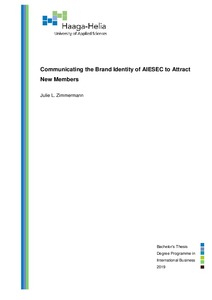Communicating the Brand Identity of AIESEC to Attract New Members
Zimmermann, Julie (2019)
Zimmermann, Julie
2019
All rights reserved. This publication is copyrighted. You may download, display and print it for Your own personal use. Commercial use is prohibited.
Julkaisun pysyvä osoite on
https://urn.fi/URN:NBN:fi:amk-2019052110971
https://urn.fi/URN:NBN:fi:amk-2019052110971
Tiivistelmä
The objective of this thesis was to uncover how Association Internationale des Étudiants en Sciences Économiques et Commerciales (AIESEC) could communicate its brand identity and thereby attract Finnish students to become members of the organization. The aim of this thesis was therefore to determine how to improve the communication of the brand identity to create more consistent messages through different channels to boost the brand image and attract more Finnish students to become members of the organization.
The theoretical framework was built on theories and models related to brand identity and communication thereof. Brand identity systems, with a focus on how to establish the identity of a brand, risks related to the process of finding an identity, as well as positioning with the aim of communicating an established brand identity, made up important parts of this study. This was supported with theory from a psychological point of view with insight to the customer’s mind.
The research method was qualitative, and data was gathered through two interviews, each with a member holding a managing position in AIESEC, and through a focus group session with Finnish students as a representative sample of 18-to-30-year-old Finnish people. Secondary data research was also carried out. The findings were analysed qualitatively based on categories deriving from findings in the theoretical framework.
The findings revealed that the brand image was inconsistent with the brand identity, - lack of coherency and trust being the main drivers for a negative image - making one of the key issues to move the image from messy, unclear and untrustworthy to genuine, clear and trustworthy. Visual inconstancies related to brand logos caused by decisions made on a global level, as well as communication methods which were perceived by Finnish students to be pushy, were also found to contribute to a negative image.
In conclusion, it was found that the established brand identity/ positioning statement should be communicated in a way that creates the desired relationship, with the tone of voice based on the brand personality, while speaking to the self-image in people. Furthermore, creating a more coherent visual identity to help the recognition of the brand and its products should be considered.
The theoretical framework was built on theories and models related to brand identity and communication thereof. Brand identity systems, with a focus on how to establish the identity of a brand, risks related to the process of finding an identity, as well as positioning with the aim of communicating an established brand identity, made up important parts of this study. This was supported with theory from a psychological point of view with insight to the customer’s mind.
The research method was qualitative, and data was gathered through two interviews, each with a member holding a managing position in AIESEC, and through a focus group session with Finnish students as a representative sample of 18-to-30-year-old Finnish people. Secondary data research was also carried out. The findings were analysed qualitatively based on categories deriving from findings in the theoretical framework.
The findings revealed that the brand image was inconsistent with the brand identity, - lack of coherency and trust being the main drivers for a negative image - making one of the key issues to move the image from messy, unclear and untrustworthy to genuine, clear and trustworthy. Visual inconstancies related to brand logos caused by decisions made on a global level, as well as communication methods which were perceived by Finnish students to be pushy, were also found to contribute to a negative image.
In conclusion, it was found that the established brand identity/ positioning statement should be communicated in a way that creates the desired relationship, with the tone of voice based on the brand personality, while speaking to the self-image in people. Furthermore, creating a more coherent visual identity to help the recognition of the brand and its products should be considered.
